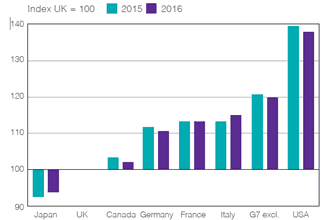Every month we’re presented with a new explanation for Britain’s low productivity – now dubbed as the ‘productivity puzzle’.
The Bank of England blames Brexit for a 5% decrease in productivity British firms three years after the referendum. But Britain has lagged behind most G7 countries since 2008 so this issue goes deeper than Brexit. It needs to be taken seriously by the government and businesses if the UK is going to be competitive on the world stage.
Gross domestic product per worker, G7 countries

The UK was the lowest performing country in the G7 in 2015 and 16 except for Japan.
Source: Office of National Statistics
Don’t blame the state, look at what you can control
We’re a pragmatic bunch at LCMB. There’s no point in railing at things beyond our control like Brexit. And while we’re all for increasing wages and annual leave (who isn’t?), this could be an expensive (and risky) way for companies to increase productivity.
Yes, external forces beyond your control such as staff health, motivation and personal issues do influence your organisation’s productivity, but it’s important to note that we spend an average of 90% of our time indoors and the key to improved productivity is probably right under your nose.
Every building we reviewed in our groundbreaking research project on buildings and productivity could significantly improve people’s wellbeing, productivity and performance by making quick and straightforward changes. For example, simply by lowering CO2 levels in the workspace, people’s cognitive speed increased by 60%, while cognitive accuracy improved by 12%.
What you should do
We recommend you take steps to improve the workplace environment. It’s the quickest, easiest and lowest cost approach to increase productivity.
Ensure your workplaces offer the best conditions for your employees to thrive in terms of productivity, performance and wellbeing. It just makes economic sense.
How to do it
We recommend you start by collecting feedback from your staff about working conditions. Next, measure the internal environmental quality of your workplace (collect metrics on factors such as air quality, noise, light, space and usage). Then prioritise the changes that will have the biggest positive impact for the least cost. Communicate your plan to your organisation, pilot the first steps, and monitor the results to inform your next steps.
Conclusion
It’s human nature to complicate things but it’s best to focus on the things you can control. Talk to us about how to design your programme to improve the workplace environment, and people’s wellbeing, productivity and performance
About our research, and further reading.
LCMB’s research project Whole Life Performance Plus (WLP+) in partnership with a consortium of world class organisations , developed an indoor environmental quality model to improve workplace productivity. Our research found that indoor environmental conditions can dramatically positively and negatively impact staff performance. These conditions include the temperature and carbon dioxide (CO2) levels which when optimised led to improvements in staff cognitive capability, speed and accuracy of work and output.
Our research has added to the growing body of research by institutions such as Harvard University that saw staff cognitive scores improve by 101% by reducing VOCs and improving ventilation.
With studies finding that UK productivity can be improved by between 2 and 3.5% by optimising workplaces, which equates to £40 – £70 billion of additional output to the UK economy, there is a big prize to be had. All this research suggests that businesses can make a step change by reviewing and optimising their existing workplaces, buildings and estates. .
Download our Ultimate guide to productivity for our guidance on the steps you can take to improve your workplace performance. Whilst you may not be able to control the impact of Brexit on your business, the research proves that optimising your workplace will deliver 2-3.5% annual productivity improvements, enough to cover the operating costs of your property.






